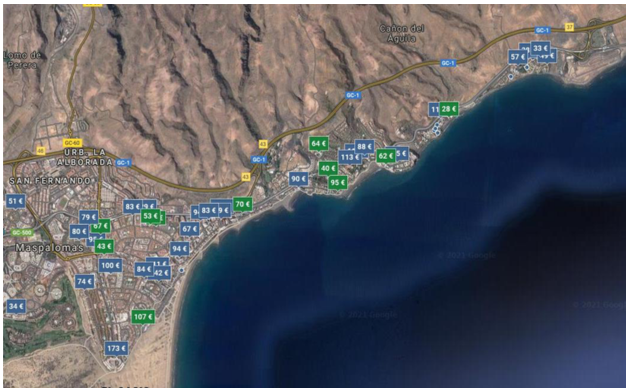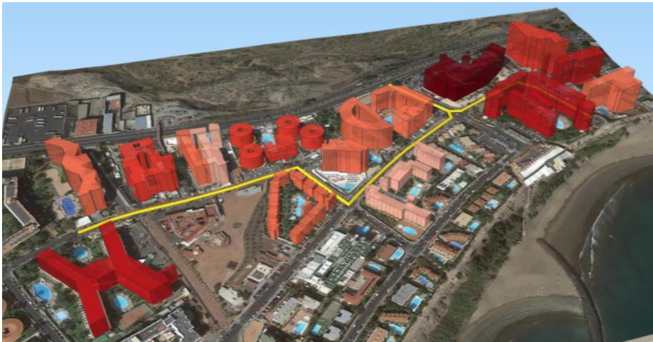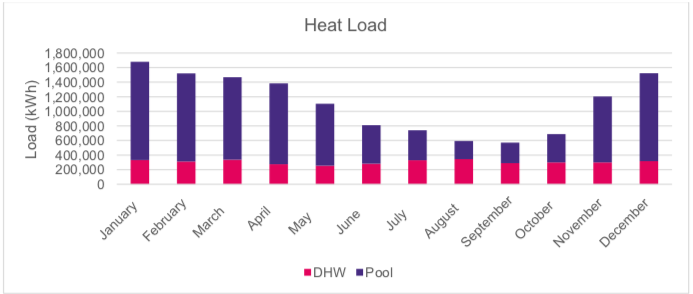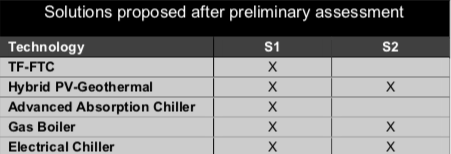Context
The Canary Islands is a Spanish archipelago in the Atlantic Ocean, which consists of Tenerife, Fuerteventura, Gran Canaria, Lanzarote, La Palma, La Gomera, El Hierro and La Graciosa.
Gran Canaria has consistent warm temperatures in spring, summer and fall, and mild winters. The average daytime high ranges from 20°C in winter to 26°C in summer. Some cool nights occur in winter, but lows below 10°C are unknown near the coast. Inland the climate is still mild but mountainous areas see the occasional frost or snow.
According to the Köppen climate classification, Gran Canaria is considered to have a desert climate (Bwh) due to its severe lack of precipitation.

In 2017, the number of visitors to the island was 4,5 million. A significant number of hotels and touristic services is located in the area around “Playa del Inglés”.

The high density of hotels, the continuous occupation during the year and the warm weather, configures the perfect case for a district cooling and, probably, heating, due to de DHW and swimming pool heating load.
Area
The Canarian Technological Institute (CTI) is developing a geo-referenced map of cooling and heating demand in Canary Islands tourist areas based on the size and category of the tourist establishment, the size of the swimming pools, and the number of users. When finished, this map will also incorporate the availability of space in the vicinity and will generate an approximation with information about the type of fuel used in the chosen area.
For the moment (until the ITC finishes its work), we will focus on simulation activities for the following area:

Energy demand
Based on the preliminary simulations, a continuous base demand of DHW is expected throughout the year, together with a high heating demand for outdoor pools, which are used the whole year. Winter load is 5 times higher than the summer one.
Regarding cooling demand, at least 6 months of required air conditioning are expected, with its peak in summer months, when heating loads are smaller.

Proposed technologies

Solar technologies
Massive use of solar technology in a large thermal system to drive advanced absorption chiller in summer and to produce heat in winter.

Advanced Absorption chiller
Use of the solar driven advanced absorption chiller, to produce a significant part of the summer cooling demand. Cooled by seawater and/or by an electrical heat pump.

Electrical Heat Pump
Coupled to the advanced absorption chiller condenser, instead of the cooling tower or the cooling well, this heat pump may produce heating recovering the rejected heat.

Hot water storage
Optimised water storage sized for acting as solar buffer.

Hybrid PV-Geothermal
Use of large reversible simultaneous heat pumps using sea as source/sink will also be analysed, fully integrated with PV.
Proposed solutions
The combination of the different technologies generates two main solutions which will be studied in the next steps (other solutions might arise during the activity):

Solution 1
This combination uses TF-FTC solar collector and the advanced solar absorption chiller using the sea for refrigeration purposes, in order to cover the main seasonal cooling demand phased with solar resource.
Heating load may be covered directly with surplus solar heat, both in summer and winter, and supported by an electrical heat pump that would be able to use the sea, but also the absorption chiller rejected heat, as heat source.
Electricity power shall be generated, at least partially, by PV on-site.
Both heating and cooling systems will include large water storage devices, establishing an optimised integration to reach the most cost-effective operation of the whole system
It also includes gas boilers and electrical chillers for peak loads.
Expected Impact
Maximised solar resource
Use of seawater as thermal source
Reduction of heat island effect
Improvement of absorption chiller performance
Avoidance of the CO2/NOx emissions
associated to the current electrical system
CAPEX and OPEX comparison with the BAU solution
Solution 2
This combination integrates electrical heat pumps working simultaneously for heating and cooling as well as refrigerated with water, including also PV to cover part of the electrical needs. It also includes gas boilers and electrical chillers for peak loads.
The use of a simultaneous operation well water condensed electrical heat pump produces the heating and cooling base load during the whole year, driven as far as possible by PV energy.
Both heating and cooling systems will include large water storage devices, establishing an optimised integration to reach the most cost-effective operation of the whole system.
Finally, conventional gas boilers and electrical chillers cover the peak loads.